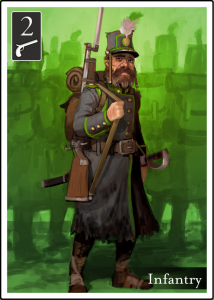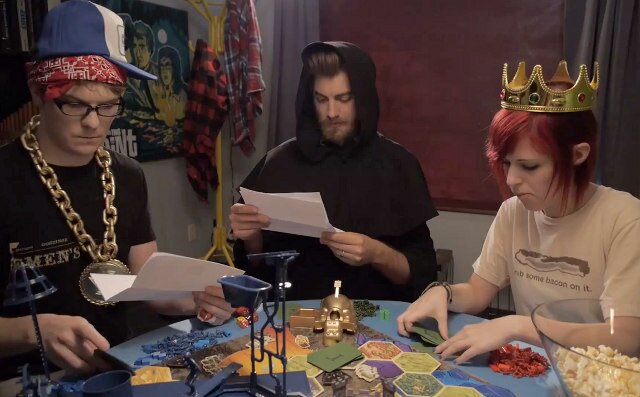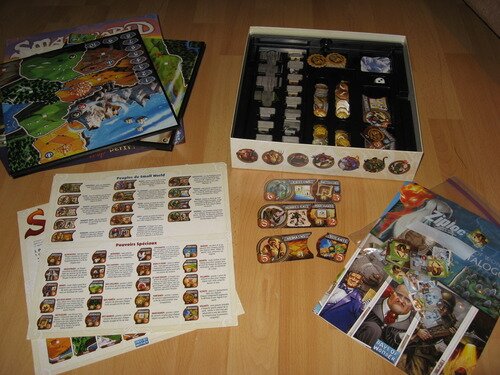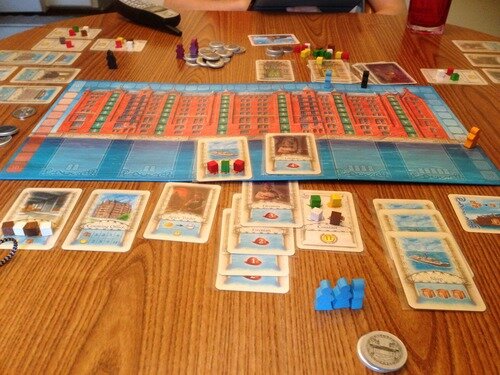Post by: The Design Community
Early in 2013 I hosted a preview for 2013, a note of things (hopefully) to come. Now, as I wrote here, it’s time to reflect and reminisce on 2013. Scroll below and read updates from some of your favorite personalities in our community. If you want to join in, email me!
Happy Mitten Games // Jeff Large
Leandra, Kyle, and I have been friends, family, and gamers for a long time. The 3 of us have always had an entrepreneurial itch and have kicked around many possible ideas. Talks of starting a board game publishing company began in early 2012 and after almost a year of research and planning we officially launched the company in spring 2013.
It’s been crazy to see the progress we’ve made since then. We knew from the beginning that we wanted to give back before we asked for anything. Thus, we consistently release a blog post or podcast episode sharing the knowledge we’ve gained and the insights from many other amazing people in the industry. In particular, our podcast has been very well received. We’ve interviewed a plethora of excellent people and in the past month, we joined the Dice Tower Network.
Along with giving back to the community, we knew building relationships would be essential to our progress and success. We have spent a lot of time meeting people on Twitter, via email, and at events like Gen Con, Origins, Protospiel, and GrandCon.
Finally, we’ve been working hard at finding games that embody our vision. We’ve had the privilege to evaluate many submissions and we’re happy to announce that we signed our first design (Details soon!). Along with this first game, we have a few other prototypes that are still being highly considered. Ideally, we would like to sign 2 or 3 games for our initial line up.
Although we feel really blessed with how things are going so far, we know there is still a long way to go. We’re excited for the work ahead and we look forward to continue earning your trust and respect.
Dave Chalker
At the time of the preview, I was working on two games, both for the possibility of self-publication depending on how it went.
The first, “Criminals,” was a co-design between my friend Kory Heath and myself, and continues to be a game I feel really strongly about. We made some tweaks since the 2007 version to address some concerns, and I paid for professional graphic design from Chris Yates, hoping to recoup the costs of the whole thing via DriveThruCards. I discussed in a blog post that didn’t work out as well as I’d hoped, and while writing that blog post lead to about 20 more sales, I’m still sufficiently in the hole and game sales are so inconsistent that I’m ready to say I need to do something else with it. As mentioned during the preview, I had hoped this would allow the game to be picked up for wider release. The game is now in the hands of publishers for review, and that process is slow yet ongoing.

Inside Joke
My party game “Inside Joke” was potentially going to be my self-published followup to “Criminals.” Since the money didn’t work out there, and since there’s a good chance “Inside Joke” would require lots more art and thus be even more expensive to produce, I’ve shelved that idea for now. I’ve pitched the game to my favorite party game publisher where it didn’t really hit. Since then, thanks to a game design retreat in June run by friends, I’ve radically simplified and made the game much more smooth and quick to play. Of course, you only get one chance to make a good first impression, so I might have missed my window with that publisher. I’ve also found it difficult to pitch party games, since I don’t have as many connections there versus more “gamer game” companies (and so many party games are designed in-house in the first place). I think the game is done: I just don’t know where to go next with it. “Inside Joke” and “Criminals” both I’m pretty sure would Kickstart well if I decided to go that direction. However, that’s a bigger deal.

Spell Dice
During all this pitching, I’ve developed two new games: one whose terrible working title is “Spell Dice” featuring a unique drafting mechanism with dice, which is in for review at a publisher. And recently, I’ve designed a microgame I’m calling “Heat” that may be a better POD game, because of how few cards and components it uses.

Heat
Of course, I’m very fortunate that “Get Bit!” continues to be popular, and this year saw the release of the “Deluxe” edition with pirate stickers and a very nice metal tin (even if it can get damaged in shipping!) It continues to be a consistent seller, as ICv2 notes, and it might lead to even bigger things. The pressure is on for some kind of follow up, which I’ve tinkered with on and off, but I won’t release a substandard game and slap a shark on it, so that may be a while.
Ed Marriott // BoardsandBarley.com
Entering the year I had made it my goal to develop a solid game with the intention of pitching the game at GenCon. At the time I only had Scoville. So naturally I focused on that. During January and February I designed and tested it about 20 times. It tested well, but all my testers were friends. I sort of wanted to “validate” their feedback so I took Scoville to Protospiel-Milwaukee in March, where it was very well received. After Protospiel I was super pumped to have received the positive feedback and I felt confident that I could spend the summer balancing, prepping, and beautifying the prototype to get it ready to pitch at GenCon.
Enter Tasty Minstrel Games. I had previously met the guys at TMG and they asked about the game. I sent a prototype and things have been rolling along nicely. We signed a contract and the game will be on Kickstarter in November, to coincide with BGG.con. I couldn’t be more excited and I hope you’ll check it out!
In January I started my game design blog, Boards & Barley, where I discuss homebrewing and game design. I’ve enjoyed the response from the readers as they share their design experiences and stories. I’ve been amazed at the game design community and how awesome it is. You people are so cool! If you’ve read my blog, thank you very much!

Quantum Orcas: This is a game that I designed on the fly for a “Design Me” article that I posted on my blog. It’s since taken on a personality all its own. Within 24 hours of designing the game it already had four playtests under its belt. Since then, I have been developing the artwork and playtesting the game. It is a 2 player game that takes about 10 minutes to play. It is light and quick while presenting enough strategy to keep people interested. My goal is to post this to The Game Crafter for POD service sometime in the next three months.
 Conclave: On the game front I designed a game called Conclave. In Conclave you are one of the preferiti, the Cardinals who are preferred to take the papacy. Your objective in the game is to manipulate the college of cardinals such that they elect you as the next pope. The game revolves around an area control mechanic where the control of different tables of cardinals is constantly changing. The downside to the design is that there is currently no build up in the game that allows you to do more things and take more awesome actions. I’ve had a plan for that since GenCon and I’m hoping to get to it in the near future. But before I do I am working on my current favorite design…
Conclave: On the game front I designed a game called Conclave. In Conclave you are one of the preferiti, the Cardinals who are preferred to take the papacy. Your objective in the game is to manipulate the college of cardinals such that they elect you as the next pope. The game revolves around an area control mechanic where the control of different tables of cardinals is constantly changing. The downside to the design is that there is currently no build up in the game that allows you to do more things and take more awesome actions. I’ve had a plan for that since GenCon and I’m hoping to get to it in the near future. But before I do I am working on my current favorite design…
Brooklyn Bridge: My very first game design was a worker placement game about brewing beer. I never really did the design justice and it sits in my basement. Unfortunately now with Brew Crafters and the European Piwne Imperium out there I’m afraid my game, Brewmaster, will never go anywhere. So I decided to bring back the worker placement mechanic and design a game around the building of the Brooklyn Bridge. It’s a fascinating feat of engineering and discovery that I think people will enjoy as a game. In the game you represent a crew of workers and it is your job to be the best crew. The best is determined by who has earned the most money at the end of construction. Money is earned by sending workers to work on different parts of the bridge. If you send them below the waterline to work in the caisson they’ll earn more but the run the risk of being out of commission if they get caisson’s disease. Sending them to work on the towers has low income, but it’s income you can count on. The big part of the game is the materials office where you are competing to get the best goods possible. I’m very excited to see where this design goes and I think it has potential.
I think 2014 is gonna be a great year! I’ve been able to make tons of great connections with fellow gamers and designers and it’s an honor to even be a part of this article. Thanks, Grant, for putting this together!
Corey Young: Corey told a story for his. Basically, you’ll see his “chapter highlights” in bold, with details following. Enjoy this great tale!
I signed a deal with Cryptozoic in the fall of 2012 to have my first game, Gravwell, published.
I pitched Gravwell to Cryptozoic at Gen Con 2013. One week later, they told me that they wanted to publish it. Other than signing the contract, not much occurred during 2012. The first few months of 2013 were pretty quiet. Matt Hyra, the Cryptozoic game developer responsible for refining Gravwell, did extensive playtesting, corresponding with me throughout.
In April, I started getting some updates showing the board, the ships, the cards and eventually the box. I was happy with everything I saw. The only change I recommended was adding infographic back to the board.
I got to meet up with a lot of great game designers around the country. I met Ben Rosset (via our mutual friend, David Miller) in DC, Ed Marriott, Brett Myers and John Kovalic in Madison, and Christopher Chung at Snakes & Lattes in Toronto.
One of the few perks of my all-travel-all-the-time job is that I get to meet my Twitter friends in person. Chatting with other game designers one-on-one is so invigorating.
Leading up to Gen Con, it did not look like Gravwell would be available for sale in time for the show.
The good folks at Cryptozoic told me early on that getting the game together in time for GenCon would be a stretch. They were confident that they could get a few copies ahead of schedule for demonstrations, but most likely not enough to actually sell them at the show.
I showed the first version of Santorini at an UnPub event.
On March 30th, Epic Loot Games hosted an UnPub event as part of their Tabletop Day celebration. I worked with John Moller and the UnPub folks to organize the event. I was there mostly as the organizer, ensuring that all the designers had enough players. The event was a great success. I got to play several promising games.
As the event was winding down, I brought out Santorini. I wasn’t sure that I would because I didn’t feel it was ready. I was mostly right. The early version still got good reactions for its visual appeal, but the game play, and my foam-core tiles, just didn’t work. I went back to the drawing board on the rules.
I also reached out to Chris Urinko for some new laser cut tiles and playing boards. I’m very glad that I did. The new components were ideal.
In July, I sold another game. This time at Protospiel.
I brought the new, simpler version of Santorini to Protospiel 2013 in Ann Arbor. There, I ran into two friends (and fellow game designers) Kevin Nunn and Mike Sullivan. They kindly sat down to try it out. Their suggestions from that first play pushed Santorini to the next level. We played again, and it really clicked. More people started watching. And queuing up to play. I was getting excited.
Then Uwe Eickert from Academy Games came by, put his hand on my shoulder, and said “I want to play that game.” A few minutes later, he was playing against another designer. As the game was winding up, Uwe said simply, “I want to make this game.”
Two weeks before GenCon, I got word that Cryptozoic would have copies of Gravwell for sale.
I hadn’t “happy danced” so hard since I got the initial “Let’s do this” email from Cryptozoic. Not only was my game going to be available at GenCon, but I would be there in the Cryptozoic booth, next to my friend John Kovalic (with his hilarious ROFL! Game), demonstrating and signing copies.
I got my advance copy of the game about the same time. I will always cherish the moment, sitting around our dining room table with my wife and kids, cutting the shrink wrap.
Best. GenCon. Ever.
As much fun as Gen Con is for a board gaming fan boy like me, it’s absolutely glorious when you attend as a published designer.
Of course, nobody knows you’re published, so it’s not at all about how anyone treats you. It simply changes how you look at everything. For starters, most of the pressure is off. I was so happy to have no prototypes in my backpack. I could just wander the floor, chatting with my growing circle of game designer friends.
When I first wandered up to the Cryptozoic booth, I saw that one of their demonstrators was showing Gravwell to some players. I looked on quietly next to my GenCon wingman, Liam Harn. I was doing my best to play it cool, but the goose bumps were coming in waves. I must have looked like a fool with a broad, toothy grin on my face.
Cryptozoic had only asked me to demonstrate for a few hours on Friday afternoon. I just couldn’t keep away. Starting Thursday morning, I orbited the booth like a dog trying to get its master’s attention. Their demonstrators did an outstanding job. I’d jump in from time to time. I was happy to show the game to several podcasters and reviewers.
And I signed some games. Damn. That’s a great feeling. I tweeted during the con that if you found me, I would mod your rules to make them say that you go first. Eight people took me up on that.
I helped out during James Mathe’s Publisher Speed Dating event at Gen Con.
On Thursday evening, I helped James Mathe conduct the first ever Publisher Speed Dating event. It was four hours of designers pitching games to publishers. My job was to bark the time and keep things moving. I was so glad that Liam was with me because by the final hour, I was out of soundage.
I broke Twitter with all my Gravwell-related tweets.
In the weeks following GenCon, I polluted Twitter with links to all the kind things people were saying about Gravwell. I won’t repeat them here. I can’t promise that I won’t start that up again once the game is released to distribution. Cryptozoic is still reporting Q4 of 2014 for that.
Jay Treat
When I showed Intrigue off at Origins, a major publisher never quite got the game, and so I recreated it as The Art of War to simplify it a bit, and to make the schemes reinforce the subtle strategies of the game rather than add variance/complexity/interest. While I don’t enjoy that version as much, I do expect it’s a better game in the sense that it will appeal to more people. I also figured out how to expand the game from 3-4 to 3-5, which is a nice get.
Unfortunately, the feedback I gleaned from GenCon was that the game has no marketable hook. It plays differently from everything else out there, but how do you convince players who know nothing about the game that from the packaging? As such, this game is going into my pocket until a publisher who trusts me is looking for a card game.
Assault on Khyber Station is currently under consideration by a small publisher, but I recently tried reinventing it to see what I could improve. I learned why certain choices have to be the way they are, but I also found a few new options that make for a more thematic game. There’s more competition for aliens-on-a-space-station games than you might expect right now, but I think Khyber Station is good enough and different enough to stand out on its own. I’m building a big Lego version of Khyber Station. It should be functional in two weeks.

Apart from figuring out that The Last Planet could be a game of coral reefs competing for the bottom of the ocean over thousands of years instead of a tactical StarCraft tile game, I’ve made no progress. I only have so much time to devote to game design and I’ve prioritized projects that are further along and are easier to iterate on. I will get there, though. The concept is too good not to.The games I’ve been meaning to get to for over a year now, Black Hills & Hollywood Disaster, still haven’t been prototyped. On the plus side, I’ve been collaborating with Cardboard Edison on Rickety Bridge & Dino Alley. Whether either of those games go anywhere or not, the shared-design experience has been rewarding. I also have two games, Possibilities & Freudian Knot in Jason Tagmire’s recently successful Storyteller Cards manual.
Oh, and I almost forgot my untitled DBRPG. I haven’t tested it yet, but I’m signed up for two sessions at Metatopia next weekend, so hopefully I’ll see if it has potential or not then. Overall, I didn’t have as much success with publishers as I imagined I finally would, and I didn’t complete all the games I would’ve liked to, but 2013 was still a year of progress, learning and making connections, so I’ll take it.
Christopher Chung
The Bad: I talked about Bucket List as my newest design for 2013, and I was very excited to work on it since it used a theme that could invoke player emotions by wanting to accomplish the various tasks on the cards throughout the game. Although I did like the theme and the mechanic of drawing cubes from a bag, the game did not work well during playtests and I will most likely incorporate the mechanic in a future game.
The Good: I worked on several titles that I will be pushing hard in early 2014.
Polar Profits is a 2-5 player game where each player is a business tycoon trying to make money in the unlikeliest of places: The North and South Poles. Invest in companies run by animals and speculate on commodities like popsicles and ice cream. I will be looking for a publisher during the spring after more playtesting.
A Wolf in Sheep’s Clothing is a 2 player game where each player is a sheep farmer trying to herd sheep while avoiding a hungry wolf. This game will be a chance for me to try out self-publishing for friends and family.

Blossom
Blossom is a 2-4 player game, where each player is a gardener attempting to plant flower beds in order to pick flowers for bouquets in an effort to win a flower competition. (picture included) This game is the most polished and enjoyed by my playtesters, so I am currently approaching publishers with this game.
Chris & Suzanne Zinsli – Cardboard Edison (@CardboardEdison)
2013 has been a big year for Cardboard Edison. In January, we took our real-time card game Tessen to Unpub 3, where it was played by dozens of other designers and players–and a publisher. That publisher was A.J. Porfirio from Van Ryder Games, and he liked Tessen so much that a few days later he made us an offer to print the game!

We spent the spring and summer developing Tessen with A.J. Working with him is a real pleasure, and we’re a bit worried that he’s given us unrealistic expectations for future publishers! At the end of the summer, Tessen completed a successful Kickstarter campaign. If all goes according to plan, the game should be in stores in just a few months.

Since the Tessen Kickstarter ended, we’ve focused heavily on a new design called Cottage Industry. The game is about fairytale contractors who build up a magical kingdom while working within the kingdom’s strict regulations. It uses a few interesting mechanisms, like a storybook that changes the course of the game, and a version of worker placement that we’re calling “worker displacement.”
We’re bringing Cottage Industry to Metatopia in a few days, so we’ve spent nearly all of our spare time over the past month playtesting and tweaking. It’s a much bigger design than anything we’ve attempted so far, and we’re extremely pleased with how it’s developing.
We’ve put Skewphemisms on the back burner for the time being, until we’re able to make some contacts at mass-market publishers. This year we’ve also met so many great people, and we’ve been honored to play a lot of our fellow designers’ games. We’re excited to see what 2014 brings for Cardboard Edison and the entire gaming industry.
Nigel Pyne // Maverick Muse
At the beginning of the year I had one game I was intent on bringing to market – Of Shot & Blade. Of Shot & Blade is an adventure board game where two teams go head-to-head in a game full of action, magic and adventure. That’s the intention anyway.
But I’m jumping ahead of myself. As way of introduction, I’m Nigel Pyne, co-designer of War for Edath that was released in 2008, and I had been working on Of Shot & Blade for over a year with my brother – Lloyd ‘Ash’ Pyne – wearing the hat of Game Editor. Ash and I also created a different fantasy setting for the game – one that you can get to know as you play. And with him being our resident artist, and my wife, Debs, being an excellent Creative Director, we make up the Maverick Muse design studio (plus Mr Jones, the Schnauzer and Lieutenant Ripley, the Welsh Terrier).
Anyway, we began the year with the intention of conducting some final beta testing and then launching Of Shot & Blade on Kickstarter. And all was going to plan when, mid-year, the solution to a game design challenge I had set myself came into actuality. The challenge was to see if I could create a card game that could be played out of the hand with no surface required – think Top Trumps – but would have enough game and challenge to appeal to youngling and olderling gamers alike. I developed my design into a full-fledged game – Oddball Aeronauts.

In Oddball Aeronauts you go head-to-head in a game of high-jinks, airship dogfights in an oddball fantasy world. The oddball fantasy setting comes from the slightly off-beat mind of Ash who has also brought the world to life with his art. This game – being composed solely of cards – is a more appropriate game as our first Kickstarter launch and so we shifted focus to getting Oddball Aeronauts – and us – ready for Kickstarter.
Oddball Aeronauts is in the final beta testing stages (a page exists for it on BGG – the rules are there) and a free P&P is available for the curious, adventurous, downright nosey or just anyone really. Email if you’re interested – .
Meanwhile, in the mysterious mind of me, several other game designs have begun to form. Whereas at the beginning of the year I had but one design I was pursuing, as of now I have eleven (excluding Of Shot & Blade and Oddball Aeronauts) and it would appear that as a game design studio we are bringing our vision into fruition. We love creating original worlds and we love games with adventure so we’re bringing the two together.

I have developed another two ‘out-of-the-hand’ card games. Once Oddball Aeronauts has taken off (fingers crossed) we will see a line of such games coming into being. A common design element I seem to be fond of for our ‘bigger’ games is team-based gaming – two teams of one to three players going head-to-head. Curious! But it seems to be an under-explored area of board games so maybe I can carve out a niche here? Or does anyone have any idea why this type of game isn’t developed much?
In summary, 2013 has been a year of planning, progression, panoply – no, not related to Monopoly – and play testing. As for 2014? Well, I hope to contribute to Grant’s 2014 preview if he’ll have me back.
David Chott
Lagoon continues to be the only game I’m actively developing, as I prepare it for a Kickstarter launch in early 2014. It will be published by my own Three Hares Games. Here’s a current description of the game:
“Players explore the fantasy world of Lagoon with their druids by drawing and placing hex tiles that represent enchanted lands. Each site is inhabited by one of three ancient spirits that confer a unique magic power to druids in the site. Players shape the ever-changing selection of magic in the world by choosing which new sites to add, and which sites to remove by magically unraveling them. But every move alters the balance of power between the spirits, in their struggle for control of Lagoon’s destiny. In the end, one spirit will achieve primacy in the world, and the victor will be the player most responsible for bending destiny in favor of that spirit!”
I’ve run about 70 play tests of Lagoon to date, and the game system has not changed since intensive testing at GenCon in August. The core is solid. But there’s been a huge amount of experimentation with the magic abilities each site offers druids. Most of my efforts have focused on simplifying the action set. My goal is to make the game as easy to learn and play as possible, while preserving the most interesting choices the game presents players. But I’ve learned that determining a game’s target audience is equally important in this process so you don’t wander too far away from it.
I’ve learned a lesson about prototype iteration as well. Lagoon uses 24 double-sided hexagon tiles, so making prototypes is laborious. This led me to iterate less frequently than I needed to, until I realized paper-only prototypes worked almost as well as pasting the sites on rigid tiles every time. It really taught me the importance of removing barriers to rapid prototype iteration, since that’s critical to getting new changes on the table and testing them.
Two developments have been the most exciting for me. The first is that a good number of players really like Lagoon! It ranked number 3 on one reviewer’s top 10 games of GenCon, and a remote play tester I gained at GenCon recently told me it’s one of his favorite games. Second, I recently quit my job and switched to part-time consulting work so I can focus most of my time and energy on developing Lagoon and building Three Hares Games.
Michael Iachini

Where things stood at the beginning of the year: Chaos & Alchemy had been signed for publication by Game Salute, and they were starting to prep for a Kickstarter campaign.
I had recently abandoned my National Game Design Month project, Gods & Champions, since it ended up exploring a concept that wasn’t as much fun as I had hoped.
I had an idea for a “worker movement” game that I began designing on January 1. I was hoping that this would turn into something fun, but I hadn’t actually done any design yet.
Looking back on the year so far: While the Chaos & Alchemy Kickstarter campaign from Game Salute ended up launching several months later than I was expected, it was a huge hit! The game raised over $40,000 with over 1,000 backers. The art is looking fantastic, and I’m excited to see the finished products in game stores and gamers’ hands next year.

The worker movement game turned into Alchemy Bazaar. The design time on this one has been much longer than the ultra-quick process I went through for Chaos & Alchemy in 2012, but I think it’s going to be worth it. I pitched the game to several publishers at GenCon 2013, and I have three publishers who are interested (with a pretty good idea of which one is most likely to pick it up).
I also started a new design in March 2013 for a quick, light, cooperative game themed around mountain climbing, which I’m calling Everest. I pitched this to game publishers at GenCon as well, and I have one publisher who is deep into the evaluation process (they’ve paid to have some nice prototypes created via The Game Crafter, and those are currently with play testers), so there’s a real possibility I’ll end up with another publication soon!

Beyond that, I’ve done some design work on a game involving robots battling in an area (cleverly titled Robo Battle for now) and super-early design work on a game about building ridiculous mansions. I have a notion in my head for an adorable game for kids, but that one is just in the “in my head” stages for now. So, 2013 has been fantastic for me and for Clay Crucible Games!
Grant Rodiek // Hyperbole Games
2013 was a very challenging year for me, but it was the year where I figured out what I want to be when I grow up, so to speak. I believe the work I put into 2013 and the lessons learned will be things from which I draw for years to come.

At the start of 2013 I had high hopes for York, which was with a publisher. It was rejected, then again, and is now with its third and final publisher. I had a fantastic pitch at GenCon, so even if it fails, that moment was thrilling.
If this publisher says no, I will re-factor the game for a POD release. I spent money on the art, which I love, and have some ideas for how to make it affordable and appealing for those interested. A hint, if you’re curious, is that it’ll be a 2 player game.
I learned so much in the way of graphic design building York. My prototypes generally look better, faster, and are easier to learn as a result of better graphics.
I also had some delightful failures. I still couldn’t figure out Poor Abby, Helix was instantly amazing then instantly the worst thing ever, Extra Extra was never built, Drafty Dungeon was neat, but derivative, and so forth. But, the lesson was to constantly be creating. In 2013 I was always trying new things and experimenting and that has led to delightful fruit. I also learned to work on multiple projects at once, which means my brain is always firing in different ways.
I continued to network and develop relationships that I hope pay off, both in the way of friendship, and in potential game partnerships as I improve my craft and design better games. One really important realization I had around GenCon was that I very honestly realized who I want to work with, and who I don’t.

My greatest successes of 2013 have been Mars Rising (previously Blockade) and Flipped.
Mars began as a simple tactics game (somewhat as a response to the complexity of York), and has blossomed into this accessible yet complex, highly thematic, story driven tactical experience. I’ve gone through so many iterations and I really love where it’s at. I don’t intend to change the mechanics much, but instead, focus on scenario development. I have the first 3 written and in testing and will create as many as I need to tell the first campaign (of hopefully many). A publisher approached me over the summer, mostly liked the version I sent, and is waiting on my next iteration. I hope I’m up to the task.

Finally, there’s Flipped. I feel like this is my capstone project that combines so many things that I’ve learned in the way of tuning, design, balancing, graphics, and more. This is my first euro and it’s come together so quickly as I’ve focused on what makes it unique and what the game needs. I’m crunching to get this game to a publisher. We’ll see where it goes.
I hope you enjoyed this community post! I want to thank all of the designers who emailed me to participate. Share your thoughts on what excites you, or what you found interesting above, down in the comments.






